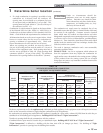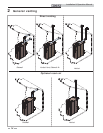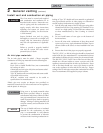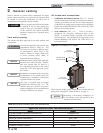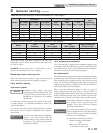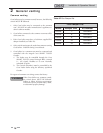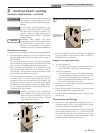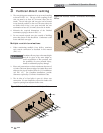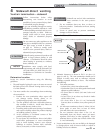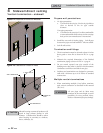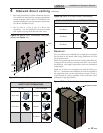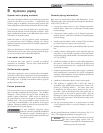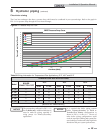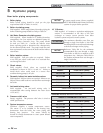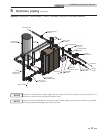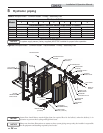
Installation & Operation Manual
3. Maintain clearances as shown in FIG.’s 4-1 thru 4-3,
pages 21 and 22. The vent termination should not be
located in traffic areas such as walkways, adjacent
buildings, operable windows, or doors. Also maintain
the following:
a. Vent must terminate:
• At least 6 feet (1.8 m) from adjacent walls.
• Not less than 7 feet (2.1 m) above grade where located
adjacent to public walkways.
• No closer than 12 inches (305 mm) below roof
overhang.
• At least 3 feet (.9 m) above any forced air intake
within 10 feet (3 m).
• No closer than 4 feet (1.2 m) horizontally
from any door or window or any other gravity air
inlet.
b. Air inlet must terminate at least 12 inches (305 m)
above grade or snow line; at least 36 inches
(914 mm) below the vent termination.
c. Do not terminate closer than 4 feet (1.2 m)
horizontally from any electric meter, gas meter,
regulator, relief valve, or other equipment. Never
terminate above or below any of these within 4 feet
(1.2 m) horizontally.
4. Locate terminations so they are not likely to be damaged
by foreign objects, such as stones or balls, or subject to
buildup of leaves or sediment.
12" MIN
GRADE OR
SNOW LINE
TO BOILER INTAKE
AIR CONNECTION
FROM BOILER VENT
PIPE CONNECTION
36" MIN
48" MAX
Figure 4-1 Sidewall Termination of Air and Vent
PVC/CPVC or ABS is acceptable air inlet pipe material.
NOTICE
4 Sidewall direct venting
Vent/air termination – sidewall
Follow instructions below when
determining vent location to avoid
possibility of severe personal injury, death,
or substantial property damage.
A gas vent extending through an exterior
wall shall not terminate adjacent to a wall
or below building extensions such as eaves,
parapets, balconies, or decks. Failure to
comply could result in severe personal
injury, death, or substantial property
damage.
Installation must comply with local
requirements and with the National Fuel
Gas Code, NFPA 54 / ANSI Z223.1 for U.S.
installations or CSA B149.1 for Canadian
installations.
Determine location
Locate the vent/air terminations using the following
guidelines:
1. The total length of piping for vent or air must not exceed
the limits given in the General Venting Section on page
17 of this manual.
2. You must consider the surroundings when terminating
the vent and air:
a. Position the vent termination where vapors will
not damage nearby shrubs, plants or air
conditioning equipment or be objectionable.
b. The flue products will form a noticeable plume as
they condense in cold air. Avoid areas where the
plume could obstruct window views.
c. Prevailing winds could cause freezing of condensate
and water/ice buildup where flue products impinge
on building surfaces or plants.
d. Avoid possibility of accidental contact of flue
products with people or pets.
e. Do not locate the terminations where wind eddies
could affect performance or cause recirculation,
such as inside building corners, near adjacent
buildings or surfaces, window wells, stairwells,
alcoves, courtyards, or other recessed areas.
ƽ WARNING
ƽ WARNING
NOTICE
ƽ WARNING
Do not connect any other appliance to the
vent pipe or multiple boilers to a common
vent pipe except as noted in Section 2
on page 18. Failure to comply could
result in severe personal injury, death, or
substantial property damage.
f. Do not terminate above any door or above or
below any window. Condensate can freeze, causing
ice formations.
g. Locate or guard vent to prevent condensate
damage to exterior finishes.
ƽ WARNING
Sidewall vent and air inlet terminations
must terminate in the same pressure
zone.
21
ƽ CAUTION
Sidewall venting commercial products will
result in large exhaust plumes in cold
climates. Consideration should be taken
when locating in proximity to windows,
doors, walkways, etc.



